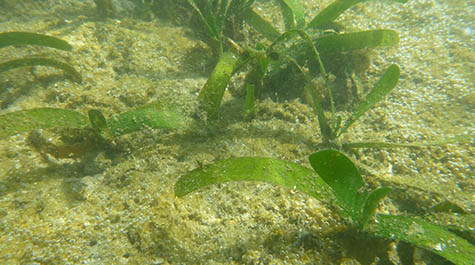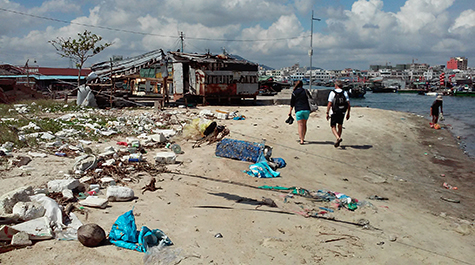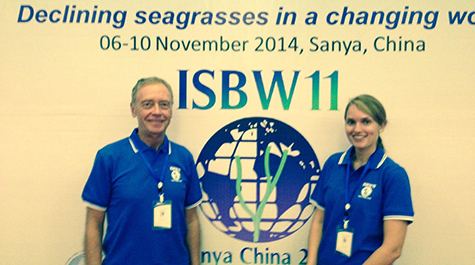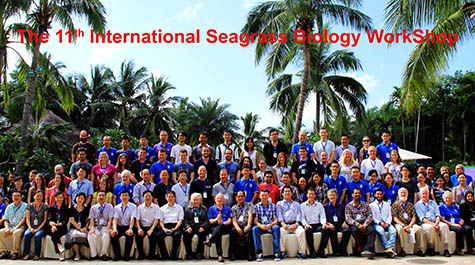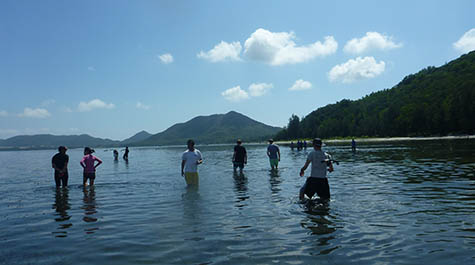VIMS student, prof aid in evaluation of global seagrass status
Seagrass meadows, one of the most rapidly disappearing ecosystems on Earth, are losing about 7% of their known acreage per year. In November, VIMS graduate student Emily French sat down with 100 leading seagrass scientists and conservationists to discuss and update the global status of this critical habitat.
French and her advisor VIMS Professor Kenneth Moore helped the Seagrass Species Specialist Group—part of the International Union for the Conservation of Nature (IUCN)—confirm the alarming loss of these important ecosystems during the 11th International Seagrass Biology Workshop in Sanya, China.
French and Moore’s research—in addition to studies and monitoring by other scientists at the conference—shows that despite initiatives for seagrass recovery and conservation in some areas, all regions of the globe are experiencing the loss of seagrass habitat due to pollution and rapid development along the world’s coastlines.
Two of only six Americans at the conference, French and Moore joined the North Atlantic group to develop a concise description of seagrass health and research needs in the region. They then joined with teams representing other “bioregions” to listen to and critique each other’s statements.
French’s group reported that seagrasses on both sides of the North Atlantic protect shorelines, are living filters, help offset the human carbon footprint, and provide nursery habitat for crabs, flounder, and other important species. They also noted that the region’s dominant seagrass species—eelgrass—is in decline due to unsustainable use of the coast including sewage discharge, shoreline hardening, and deforestation.
“As seagrass continues to decline globally because of poor water quality and rising temperatures, our approach may change from conservation and restoration to mitigation of lost seagrass abundance,” says French. “It may be more successful to plant seagrass that is capable of withstanding degraded environmental conditions than to try to restore the original seagrass lost.” The group concluded that science contributes to seagrass management, but more proactive conservation is needed.
French’s graduate research focuses on the types of changes in ecosystem services that might occur if widgeongrass, a seagrass species that can withstand warmer waters, were to replace eelgrass in some places in Chesapeake Bay. It is research that is especially pertinent to the conference theme: Declining Seagrasses in a Changing World.
“Widgeongrass—which like eelgrass is native to the Bay—is capable of surviving in more extreme conditions,” says French. “When eelgrass dies back, the widgeongrass growing alongside it is released from competition and can move into some of the areas the eelgrass previously occupied.”
French says her research will throw light on how ecosystem services are likely to change if widgeongrass replaces eelgrass, and then apply that to the ecosystem services we could expect if widgeongrass is used in a restoration setting. “This concept applies to areas worldwide where seagrass is in decline, but there is an alternate species capable of withstanding degraded environmental conditions,” she says.
French and Moore traveled to the conference using funds provided by Moore’s 2014 Plumeri Award. The gift—established with a generous gift from William & Mary alumnus Joseph J. Plumeri II—recognizes 20 faculty members each year for exemplary achievements in teaching, research, and service. Moore, like other Plumeri winners, used the award to enhance his research and teaching and to support travel to scholarly conferences.
“The Plumeri award enables faculty to support travel for themselves and their students to meetings like this one, which enables us to interact with international colleagues and expand the reputation of W&M and VIMS,” Moore says.
French says interacting with the international community was inspiring, and helped her put her own research into context. “It made me even more excited to continue to make progress in my own research and communication of seagrass importance,” she says.
French says the highlight of the conference was expanding her horizons in terms of global seagrass research. “My view of seagrass gets restricted to Chesapeake Bay,” she says. “Seagrass occurs worldwide and I got to talk to people about how a worm was affecting eelgrass beds in Denmark, deforestation and mobilization of sediment was affecting seagrass in Thailand, the success of an educational program in the Mediterranean, and much more.”
French says while she doesn’t know if she will be able to attend the conference next year, she hopes that seagrasses will be on the rise by then and that there is good news from regions underrepresented in terms of seagrass research.
Read the summaries on regional seagrass status and health assembled by the scientists during the International Seagrass Biology Workshop here.


